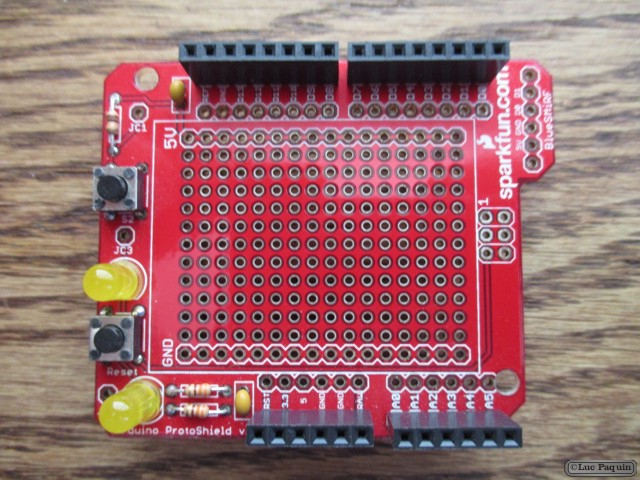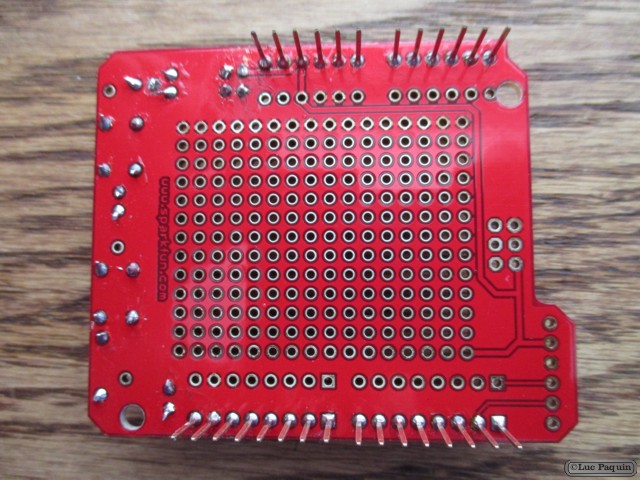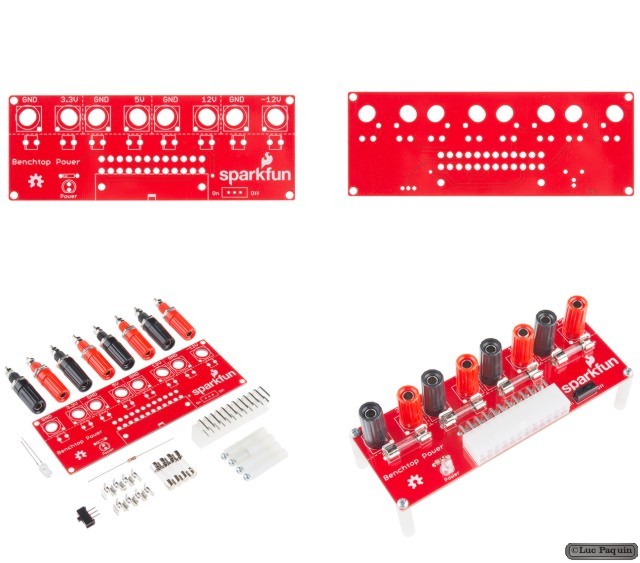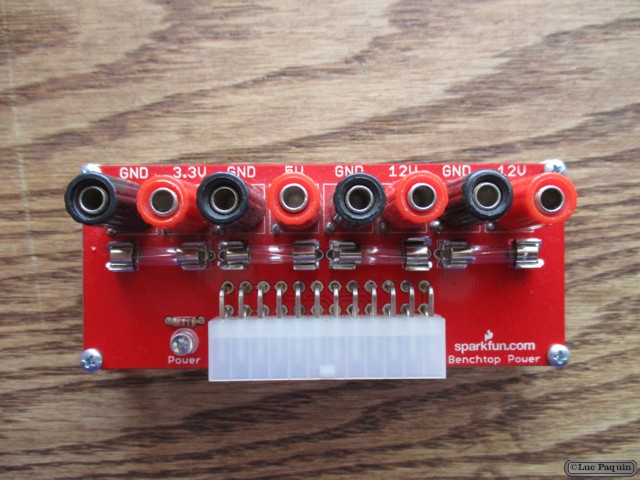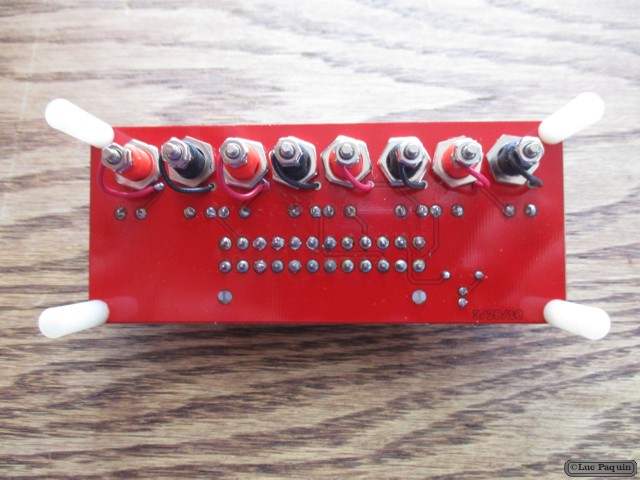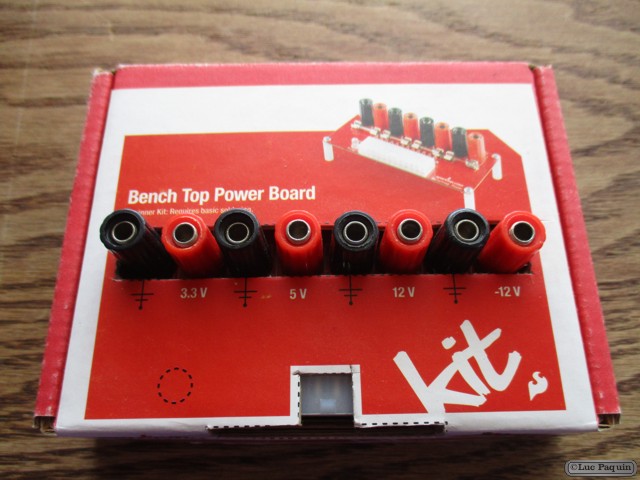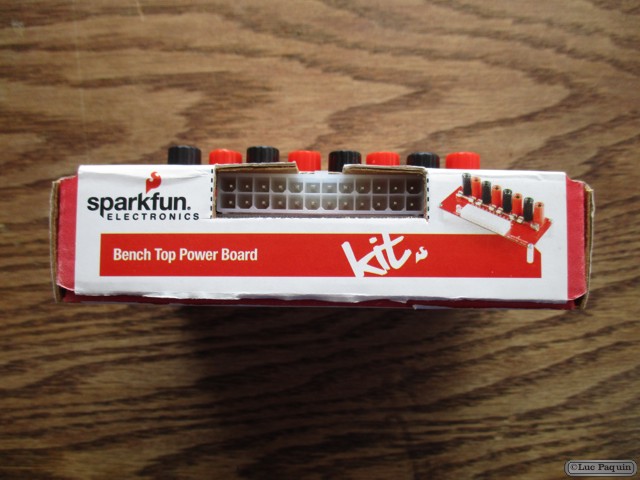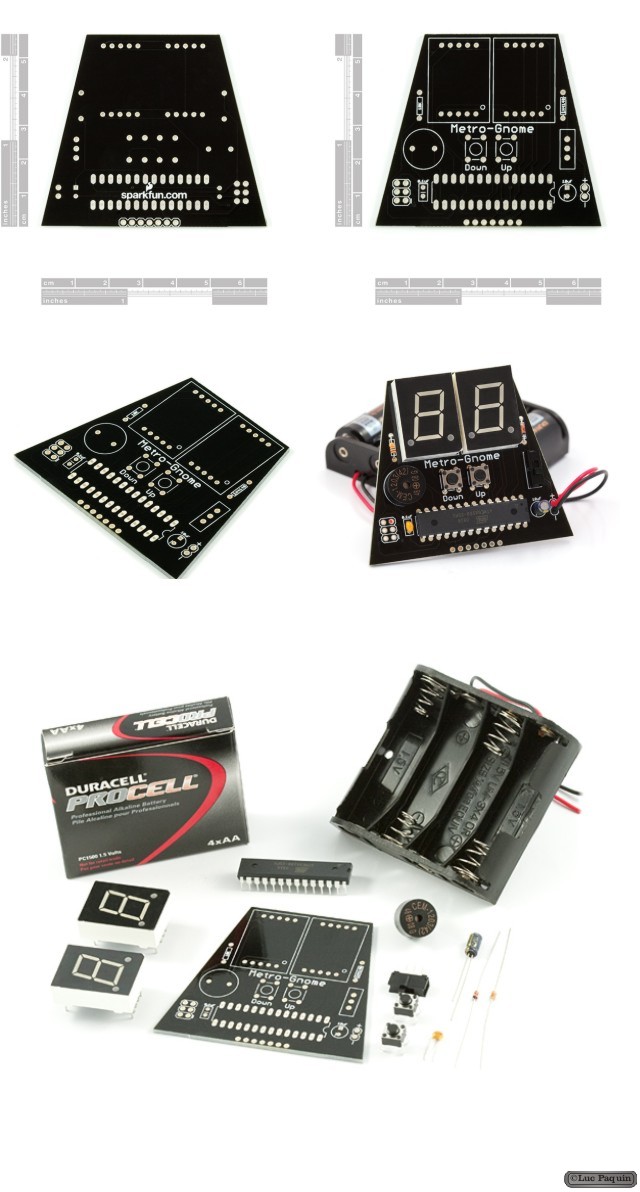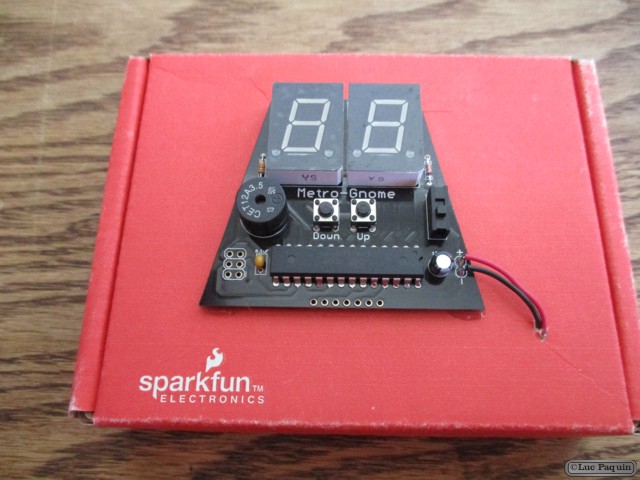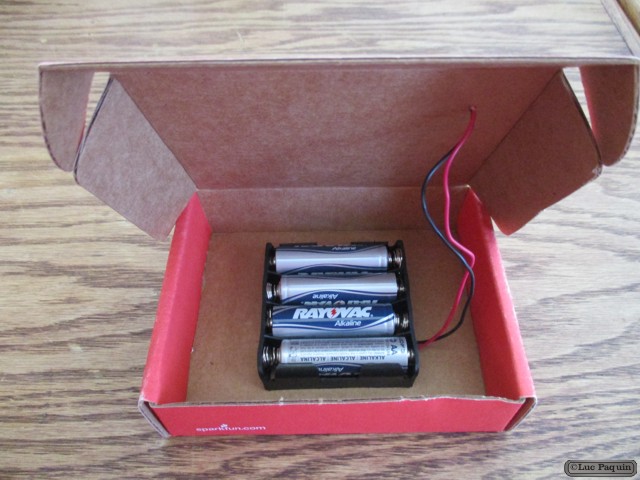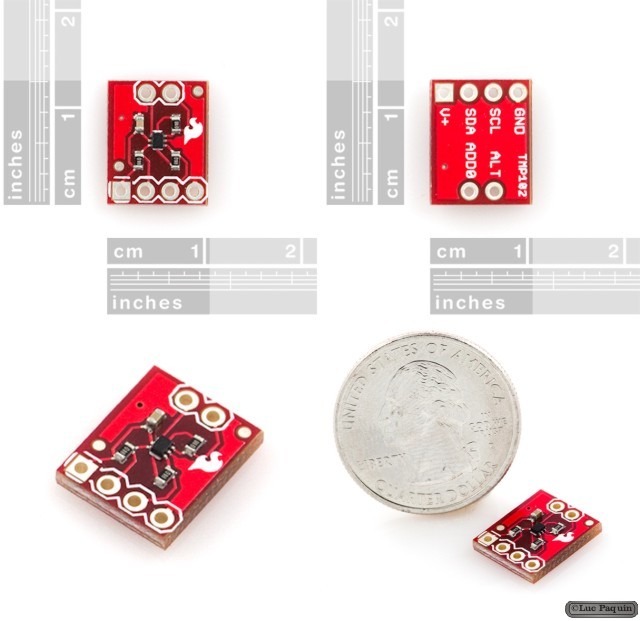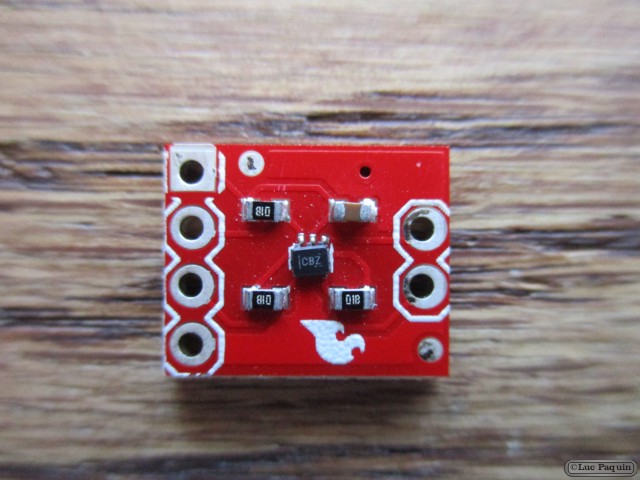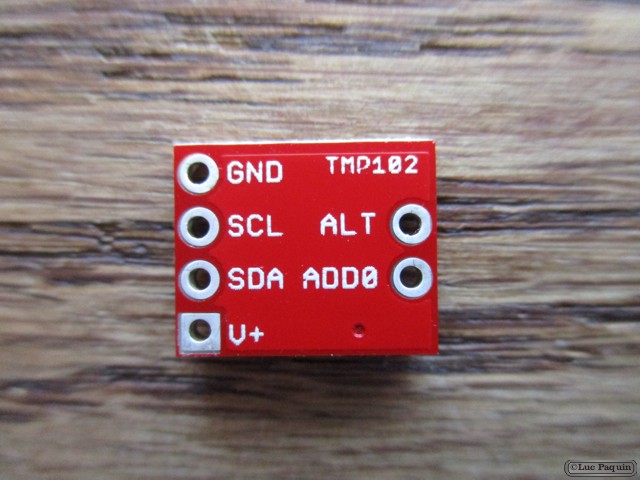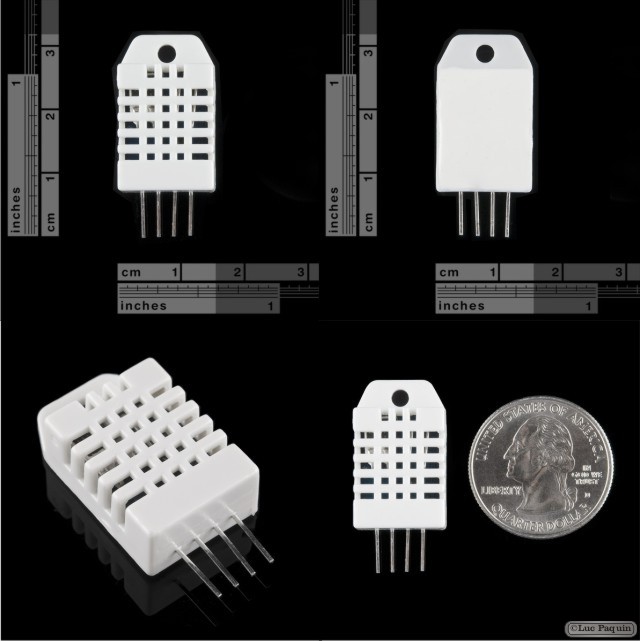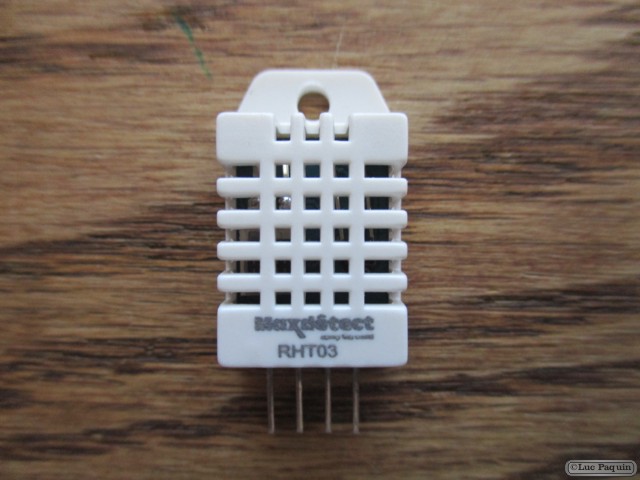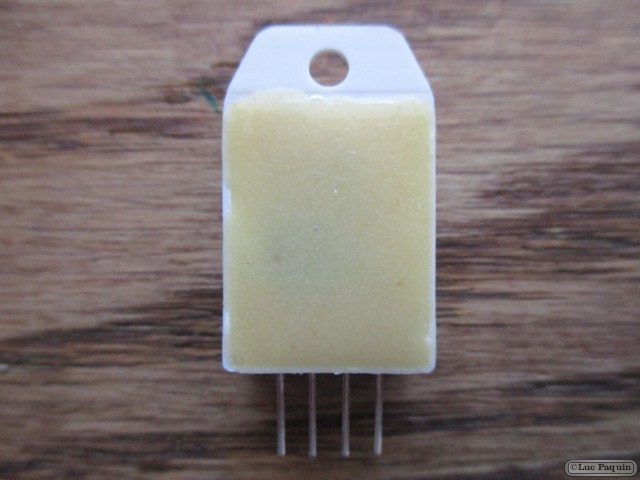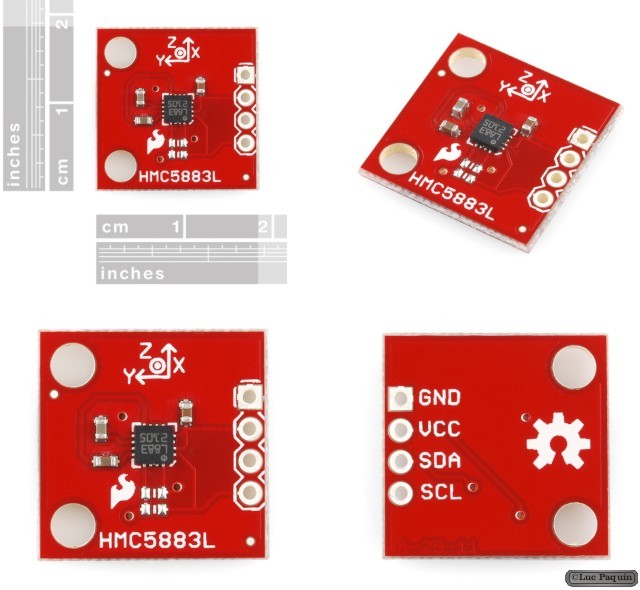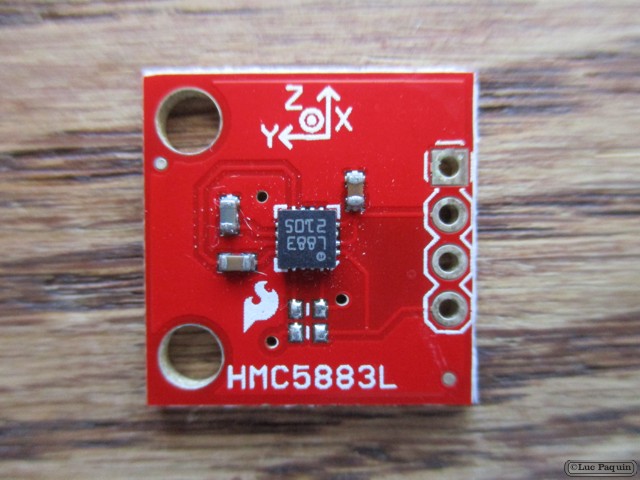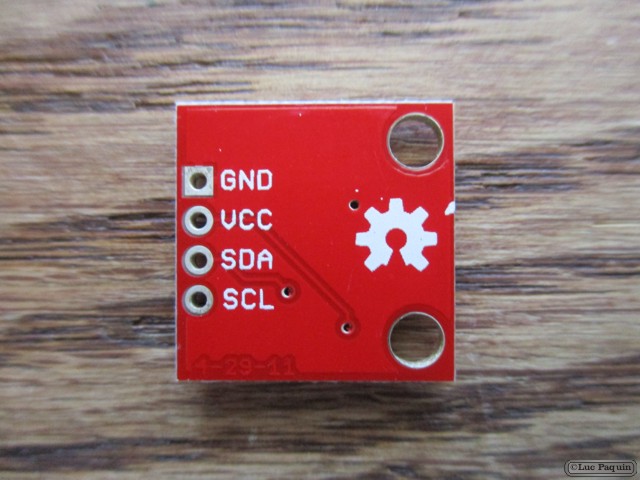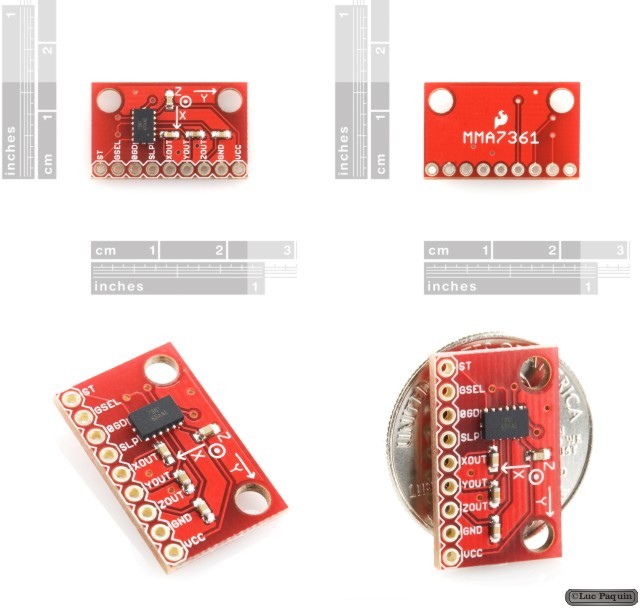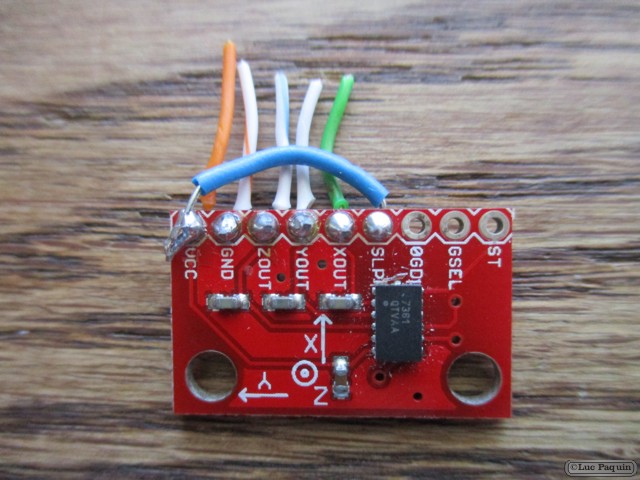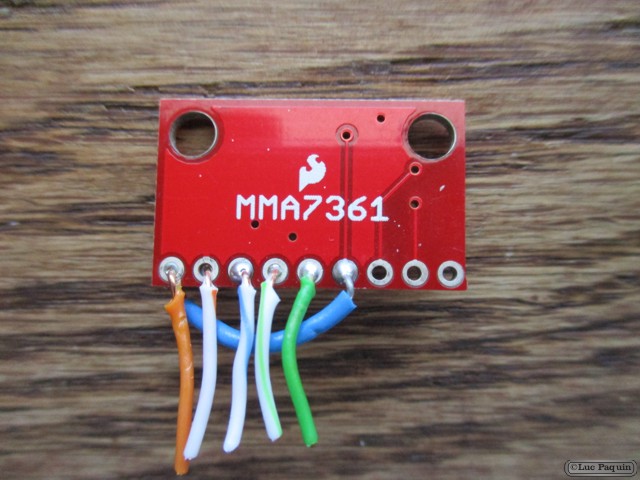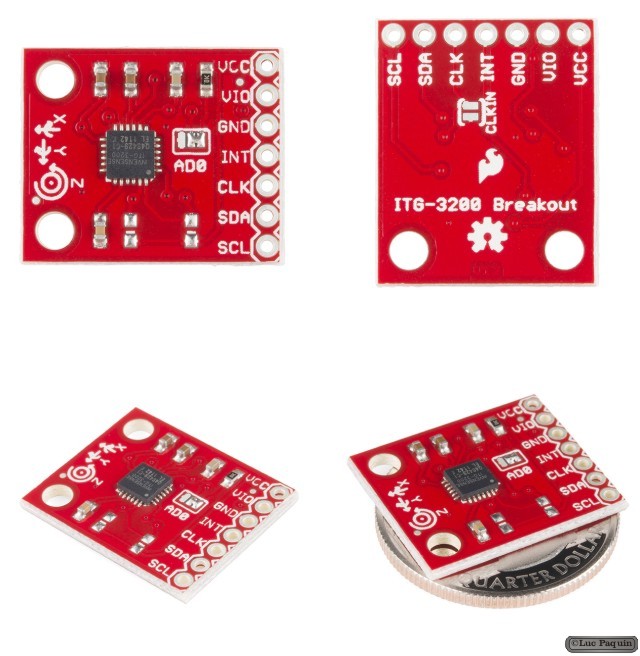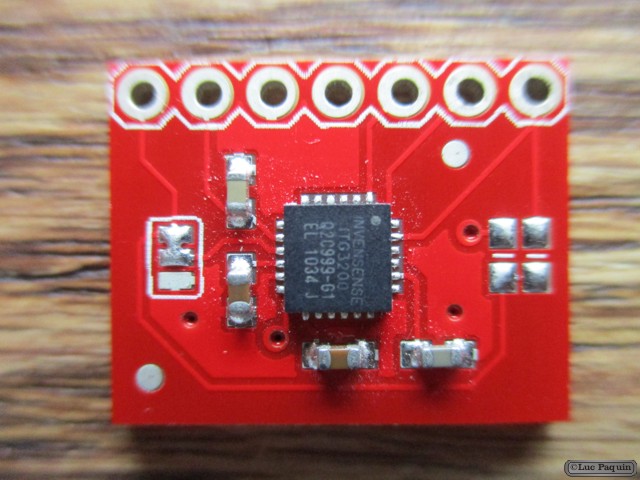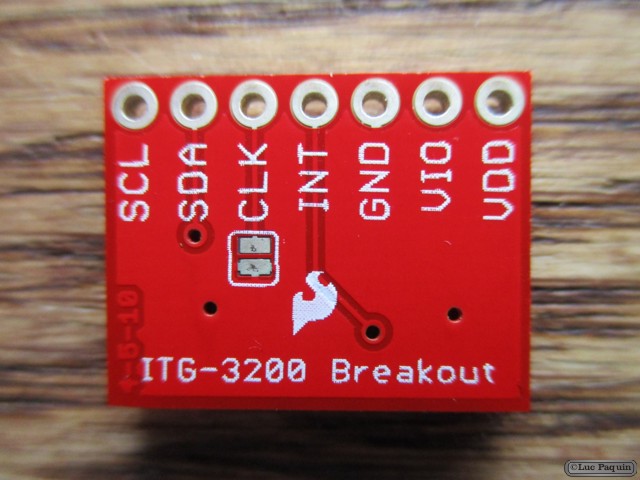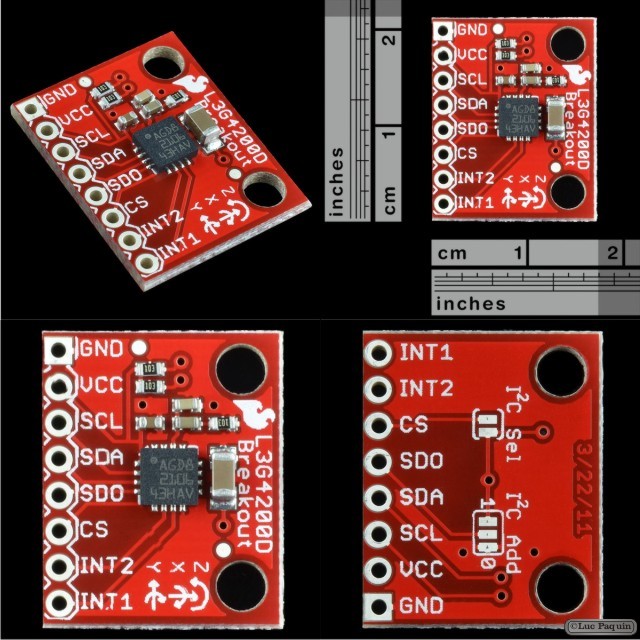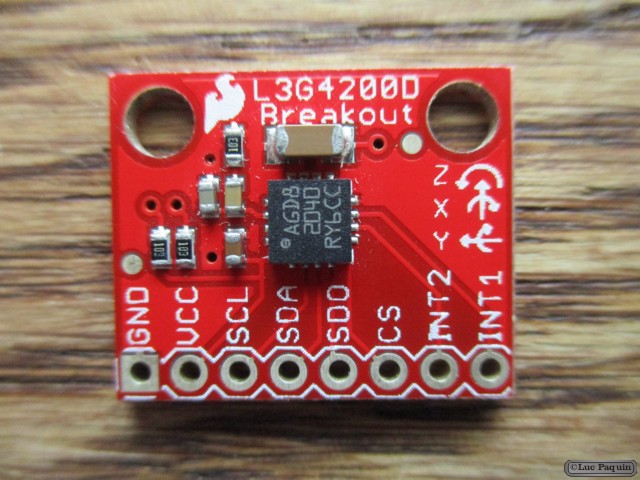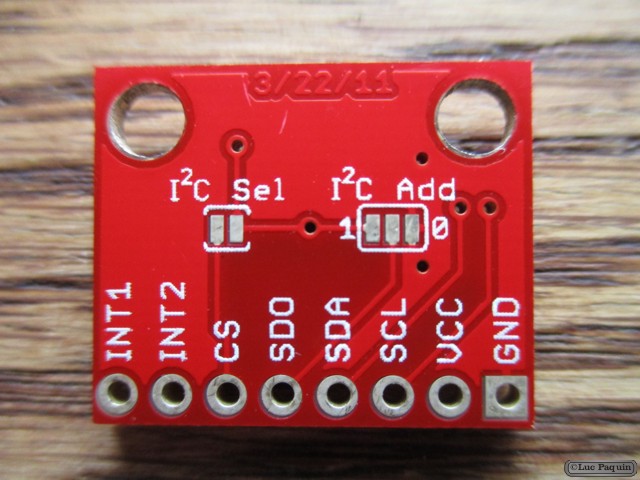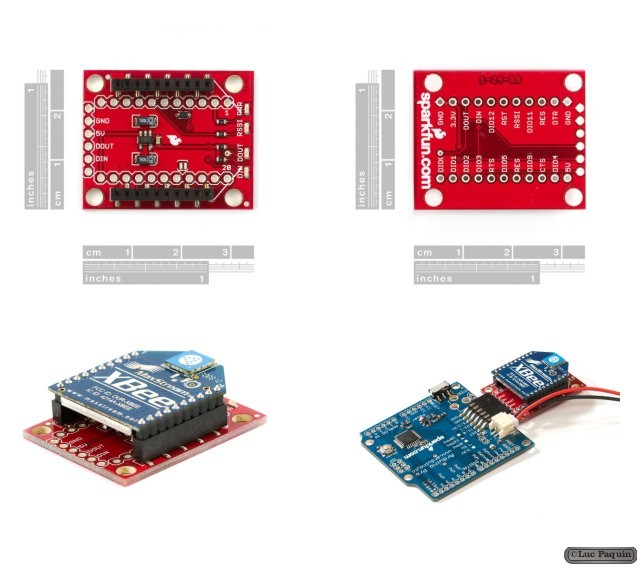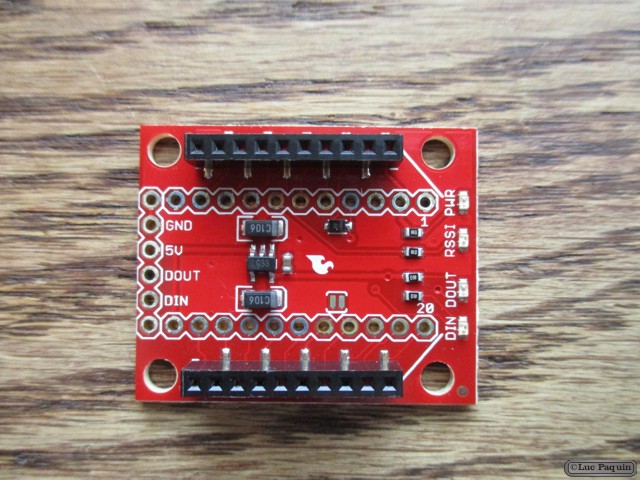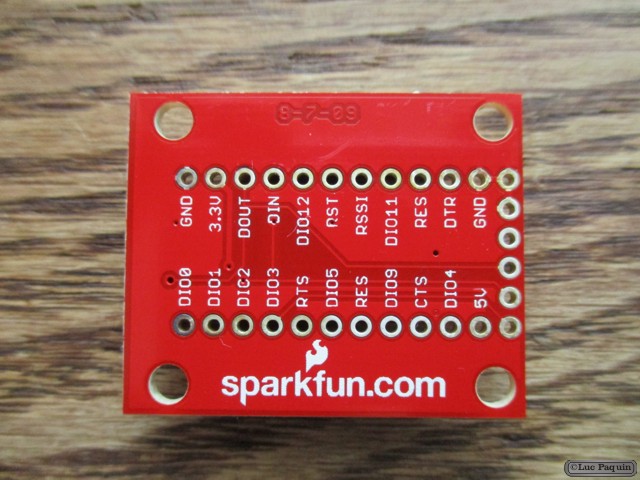SparkFun – ProtoShield Kit
SparkFun: DEV-07914
Description: Riding on the waves of the very popular Arduino USB board is this small prototyping shield. Originally spawned with collaboration between the folks at SFE and ITP @ NYU, the ProtoShield mates with the Arduino USB board and gives the user a small soldering area, two general LEDs, access to a BlueSMiRF socket, a general pushbutton switch, and most important of all – the Arduino reset switch is brought to the top level. A ProtoShield quickstart guide is available!
This comes in kit form and must be soldered together by the end user. Please note – we do not ship assembly instructions, but you can find a big, clean photographed assembly guide here! There are a few tutorials on assembly listed below. All soldering is through-hole (relatively easy) but always check your component orientation before soldering!
The kit is pictured with the bread-board option. We highly recommend this breadboard! See the related items below for all the colorful options of breadboards you have.
Note: The SparkFun ProtoShield Kit does not include the holes for the Uno R3 SDA and SCL.
Kit Includes:
- 1 x ProtoShield bare PCB
- 2 x Stackable Headers 6-pin
- 2 x Stackable Headers 8-pin
- 2 x 5mm Basic Yellow LEDs
- 2 x 330 Ohm resistors
- 1 x 10k resistor
- 2 x Momentary push buttons
- 2 x 0.1uF Ceramic Capacitors
Features:
- All Arduino pins are brought to the top level
- 5V, GND, and Vin pins are exposed as well
- BlueSMiRF socket for wireless communication between Arduinos
- 2 general use LEDs
- 1 general use button
- Reset button brought to top level
Don Luc
SparkFun – Benchtop Power Board Kit
SparkFun: KIT-12867
Description: You don’t have the power? Well, there’s no need to ask Scotty – the SparkFun Benchtop Power Board Kit has your back. This board will let you take advantage of your power supply to create a benchtop power supply with enough juice to run almost any of your embedded electronics projects.
The benchtop power board kit was created to provide quick access to the typical voltages needed when developing physical computing projects (embedded systems). After assembling the kit you’ll have access to four different voltages (3.3V, 5V, 12V and -12V) each with their own replaceable 5A fuse. Each power rail has a corresponding ground connection; all of the power rails are brought out to a binding post. The benchtop power board should be powered by a standard computer power supply with an ATX connector. With this rev we have finally added a power switch and made each standoff to a more appropriate height to fit the mounting posts.
This kit is simple to put together and shouldn’t take more than 30-45 minutes for a beginner.
Don Luc
SparkFun – Metro-Gnome
SparkFun: KIT-09236
Description: The SparkFun Metro-Gnome is a basic digital metronome used to keep time during music practice. This is a basic kit that goes together in 15-20 minutes for people learning to solder, and 5-10 minutes for those with a bit of experience.
Kit Includes:
- 1 x Metro-Gnome PCB
- 1 x ATmega168
- 2 x 7-segment red LED
- 1 x 10uF cap
- 1 x 0.1uF cap
- 1 x 10k resistor
- 1 x 1N4148 diode
- 1 x Piezo Speaker
- 1 x mini power switch
- 2 x push button reset switches
- 1 x battery holder pack
- 4 x 1500mAh AA Alkaline Battery
Don Luc
SparkFun – Digital Temperature Sensor Breakout – TMP102
SparkFun: SEN-09418
Description: This is a breakout board for the incredibly small TMP102 digital temperature sensor. The TMP102 is a digital sensor (I2C a.k.a. TWI), has a resolution of 0.0625°C, and is accurate up to 0.5°C. The sensor requires very low-current, and is loaded with features.
Communication with the TMP102 is achieved through a two-wire serial interface. There is no on-board voltage regulator, so supplied voltage should be between 1.4 to 3.6VDC. Filtering capacitors and pull-up resistors are included as shown.
Features:
- 12-bit, 0.0625°C resolution
- Accuracy: 0.5°C (-25°C to +85°C)
- Low quiescent current
- 1.4V to 3.6VDC supply range
- Two-wire serial interface
- 10µA Active (max)
- 1µA Shutdown (max)
Don Luc
SparkFun – Humidity and Temperature Sensor – RHT03
SparkFun: SEN-10167
Description: The RHT03 (also known by DHT-22) is a low cost humidity and temperature sensor with a single wire digital interface. The sensor is calibrated and doesn’t require extra components so you can get right to measuring relative humidity and temperature.
Features:
- 3.3-6V Input
- 1-1.5mA measuring current
- 40-50 uA standby current
- Humidity from 0-100% RH
- -40 – 80 degrees C temperature range
- +-2% RH accuracy
- +-0.5 degrees C
Don Luc
SparkFun – Triple Axis Magnetometer Breakout – HMC5883L
SparkFun: SEN-10530
Description: This is a breakout board for Honeywell’s HMC5883L, a 3-axis digital compass. Communication with the HMC5883L is simple and all done through an I2C interface. There is no on-board regulator, so a regulated voltage of 2.16-3.6VDC should be supplied.
The breakout board includes the HMC5883L sensor and all filtering capacitors as shown. The power and 2-wire interface pins are all broken out to a 0.1″ pitch header.
Features:
- Simple I2C interface
- 2.16-3.6VDC supply range
- Low current draw
- 5 milli-gauss resolution
Dimensions: 0.7×0.7″ (17.78×17.78mm)
Don Luc
SparkFun – Triple Axis Accelerometer Breakout – MMA7361
SparkFun: SEN-09652
Description: This is a breakout board for Freescale’s MMA7361L three-axis analog MEMS accelerometer. The sensor requires a very low amount of power and has a g-select input which switches the accelerometer between ±1.5g and ±6g measurement ranges. Other features include a sleep mode, signal conditioning, a 1-pole low pass filter, temperature compensation, self test, and 0g-detect which detects linear freefall. Zero-g offset and sensitivity are factory set and require no external devices.
This breadboard friendly board breaks out every pin of the MMA7361L to a 9-pin, 0.1″ pitch header. The sensor works on power between 2.2 and 3.6VDC (3.3V optimal), and typically consumes just 400µA of current. All three axes have their own analog output.
Features:
- Two selectable measuring ranges (±1.5g, ±6g)
- Breadboard friendly – 0.1″ pitch header
- Low current consumption: 400 µA
- Sleep mode: 3 µA
- Low voltage operation: 2.2 V – 3.6 V
- High sensitivity (800 mV/g at 1.5g)
- Fast turn on time (0.5 ms enable response time)
- Self test for freefall detect diagnosis
- 0g-Detect for freefall protection
- Signal conditioning with low pass filter
- Robust design, high shocks survivability
Dimensions: 0.90 x 0.50″
Don Luc
SparkFun – Triple-Axis Digital-Output Gyro Breakout – ITG-3200
SparkFun: SEN-11977
Description: This is a breakout board for InvenSense’s ITG-3200, a groundbreaking triple-axis, digital output MEMS gyroscope. The ITG-3200 features three 16-bit analog-to-digital converters (ADCs) for digitizing the gyro outputs, a user-selectable internal low-pass filter bandwidth, and a Fast-Mode I2C (400kHz) interface. Additional features include an embedded temperature sensor and a 2% accurate internal oscillator.
The ITG-3200 can be powered at anywhere between 2.1 and 3.6V. For power supply flexibility, the ITG-3200 has a separate VLOGIC reference pin (labeled VIO), in addition to its analog supply pin (VDD) which sets the logic levels of its serial interface. The VLOGIC voltage may be anywhere from 1.71V min to VDD max. For general use, VLOGIC can be tied to VCC. The normal operating current of the sensor is just 6.5mA.
Communication with the ITG-3200 is achieved over a two-wire (I2C) interface. The sensor also features a interrupt output, and an optional clock input. A jumper on the top of the board allows you to easily select the I2C address, by pulling the AD0 pin to either VCC or GND; the board is shipped with this jumper tied to VCC. If you don’t plan on using the CLKIN pin, you can short the jumper on the bottom of the board to tie it to GND.
This breakout board is shipped as shown in the images. Note that there are two unpopulated resistors on the I2C lines, these can be added later by the customer if desired.
Features:
- Digital-output X-, Y-, and Z-Axis angular rate sensors (gyros) on one integrated circuit
- Digitally-programmable low-pass filter
- Low 6.5mA operating current consumption for long battery life
- Wide VDD supply voltage range of 2.1V to 3.6V
- Standby current: 5µA
- Digital-output temperature sensor
- Fast Mode I2C (400kHz) serial interface
- Optional external clock inputs of 32.768kHz or 19.2MHz to synchronize with system clock
- Pins broken out to a breadboard friendly 7-pin 0.1″ pitch header
Dimensions: 0.87 x 0.72″ (22.22 x 18.48mm)
Don Luc
SparkFun – Tri-Axis Gyro Breakout – L3G4200D
SparkFun: SEN-10612
Description: This is a breakout board for the L3G4200D low-power three-axis angular rate sensor. The L3G4200D is a MEMS motion sensor and has a full scale of ±250/±500/±2000 dps and is capable of measuring rates with a user-selectable bandwidth. These work great in gaming and virtual reality input devices, GPS navigation systems and robotics.
Features:
- Three selectable full scales (250/500/2000 dps)
- I2C/SPI digital output interface
- 16 bit-rate value data output
- 8-bit temperature data output
- Wide supply voltage: 2.4 V to 3.6 V
- Low voltage-compatible IOs (1.8 V)
- Embedded power-down and sleep mode
- Embedded temperature sensor
- High shock survivability
Don Luc
SparkFun – XBee Explorer Regulated
SparkFun: WRL-09132
Description: The XBee Explorer Regulated takes care of the 3.3V regulation, signal conditioning, and basic activity indicators (Power, RSSI and DIN/DOUT activity LEDs). It translates the 5V serial signals to 3.3V so that you can connect a 5V (down to 3.3V) system to any XBee module. The board was conveniently designed to mate directly with Arduino Pro boards for wireless bootloading and USB based configuration.
This unit works with all XBee modules including the Series 1 and Series 2.5, standard and Pro versions. Plug an XBee into this breakout and you will have direct access to the serial and programming pins on the XBee unit and will be able to power the XBee with 5V.
This board comes fully populated with 3.3V regulator (16V max input), XBee socket, four status LEDs, and a diode to allow 5V systems to communicate safely with the 3.3V XBees. This board does not include and XBee module. XBee modules sold below.
Don Luc

